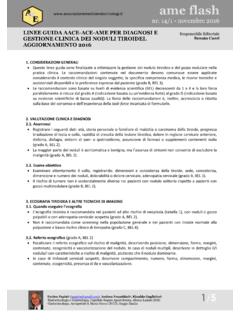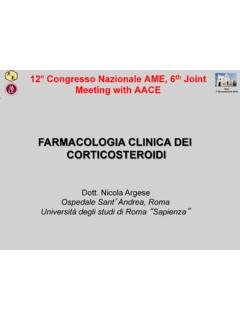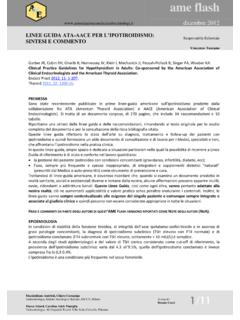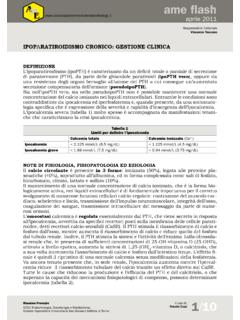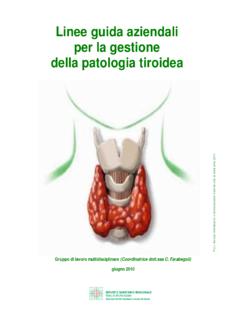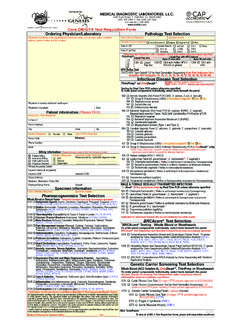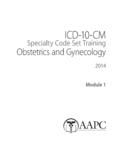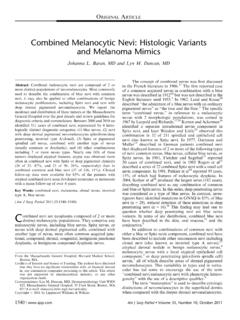Transcription of Classificazionicitologiche:verso’ …
1 Roma, 9-11 novembre 2012 Cytology and molecular biology for thyroid nodules From diagnos6c categories to clinical ac6ons Classificazioni citologiche: verso uno schema internazionale unificato? A. Crescenzi Roma, 9-11 novembre 2012 AACE-AME (2006) ATA (2006) Non diagnostic Benign Suspicious/indeterminate Malignant PSC (2007) Unsatisfactory Benign Cellular lesion, can not rule out follicular neoplasm Follicular Neoplasm Suspicious Malignant Diagnostic categories Roma, 9-11 novembre 2012 SIAPEC-SIE (2007) Tir 1.
2 Non diagnostico Tir 2. Negativo per cellule maligne Tir 3. Indeterminato (Proliferazione follicolare) Tir 4. Sospetto per malignit Tir 5. Positivo per cellule maligne BTA (2002/7) Thy 1. Non diagnostic Thy 2. Non neoplastic Thy 3. Follicular lesion Thy 4. Suspicious of malignancy Thy 5. Diagnostic of malignancy Categorie Diagnostiche Roma, 9-11 novembre 2012 TIR3: Inconclusive/indeterminated (follicular proliferation) Siapec 2007 Adenomatoid hyperplasia Follicular adenoma Follicular carcinoma Hurthle cell neoplasm Follicular variant of papillary carcinoma Worrisome follicular alterations that cannot be placed in Tir2 but are not sufficient for a Tir4 categorization.
3 Roma, 9-11 novembre 2012 Follicular proliferation Needle diameter 300 microns normal follicles 50-500 macrofollicles > 500 microfollicles 10-20 Microfollicles: Crowded, flat groups of less then 15 follicular cells arranged in circle that is at least two thirds complete Renshaw AA et al. Arch Pathol Lab Med 2006: 130: 148 Roma, 9-11 novembre 2012 Adenomatoid hyperplasia Follicular neoplasm Follicular lesion TIR3 FNA Roma, 9-11 novembre 2012 Follicular lesion TIR3 Follicular carcinoma: the diagnosis of malignancy depends primarily on the demonstration of unequivocal capsular and/or vascular invasion.
4 FNA Roma, 9-11 novembre 2012 Follicular lesion TIR3 (Follicular variant of papillary carcinoma) Roma, 9-11 novembre 2012 Medical Guidelines for Clinical Practice for the Diagnosis and Management of Thyroid Nodules Hossein Gharib, Enrico Papini, Ralf Paschke, Daniel S. Duick, Roberto Valcavi, Laszlo Hegedus, Paolo Vitti, and the AACE /AME/ETA Task Force on Thyroid Nodules. 2010 Cytologic diagnoses should be organized into 5 classes: Class 1. Nondiagnostic (inadequate or insufficient): samples with processing errors or an insufficient number of follicular cells Class 2.
5 Benign (or negative for malignancy): includes colloid or hyperplastic nodules, Hashimoto or granulomatous thyroiditis, and cysts Class 3. Follicular lesions: all follicular-patterned lesions, including follicular neoplasms, H rthle cell lesions, and the follicular variant of PTC. In centers with specific experience in thyroid cytology, follicular cytology may be further subdivided into follicular lesion/atypia of undetermined significance and follicular neoplasm. This distinction separates 2 cytologic groups at different risk for thyroid malignancy but with the same operative Indications.
6 Class 4. Suspicious: samples that suggest a malignant lesion but do not completely fulfill the criteria for a definite diagnosis Class 5. Malignant (or positive): samples characterized by malignant cytologic features that are reliably identified by the cytopathologist and are diagnostic of primary or metastatic tumors Roma, 9-11 novembre 2012 AACE /AME/ETA J Endocrinol Invest. 33 (Suppl. To no 5): 1 50, 2010 Follicular Lesions Treatment Surgical excision is recommended for most follicular thyroid lesions Intraoperative frozen section is not recommended as a routine procedure Consider clinical follow-up in the minority of cases with favorable clinical, US, cytologic, and immunocytochemical features Roma.
7 9-11 novembre 2012 Unsatisfactory Benign Atypia of undetermined significance or follicular lesion of undetermined significance Follicular Neoplasm Suspicious for malignancy Malignant Diagnos(c categories Am J Clin Pathol 2009;132:658-665 Roma, 9-11 novembre 2012 The hallmark of this diagnostic category is a disturbed cytoarchitecture: follicular cells are arranged predominantly in microfollicular or trabecular arrangements Benign follicular nodules often have a small population of microfollicles and crowded groups.)
8 If these constitute the minority of the follicular cells, they have little significance and the FNA can be interpreted as benign. A suspicious interpretation is rendered only when the majority of the follicular cells are arranged in abnormal architectural groupings (microfollicles, crowded trabeculae). Roma, 9-11 novembre 2012 BETHESDA System Diagnostic Cytopathology, 2008 Roma, 9-11 novembre 2012 UK RCPath Diagnostic category Thy1/Thy1c Non-diagnostic for cytological diagnosis Unsatisfactory, consistent with cyst Thy2/Thy2c Non-neoplastic Thy 3a Neoplasm possible atypia/non-diagnostic Thy 3f Neoplasm possible - suggesting follicular neoplasm Thy 4 Suspicious of malignancy Thy5 Malignant Roma, 9-11 novembre 2012 Gabrijela Kocjan et al.
9 Roma, 9-11 novembre 2012 Roma, 9-11 novembre 2012 2013 Italian Consensus TIR 3: Indeterminate TIR 3A Cellular microfollicular/Hurthle cell pattern in a background of sparse colloid amount with degenerative/regressive features Partially compromised specimens (blood contamination) with mild cytologic or architectural alterations Expected lower risk of malignancy TIR 3B Monotonous, repetitive microfollicular pattern with scanty or absent colloid ( follicular proliferation ) More likely follicular neoplasm; expected higher risk of neoplasia.
10 Roma, 9-11 novembre 2012 UK RCPath SIAPEC-AIT 2013 USA BETHESDA Diagnostic category Terminology Thy1/Thy1c Non-diagnostic for cytological diagnosis Unsatisfactory, consistent with cyst TIR 1 TIR 1c (cystic) I. Non-diagnostic Cystic fluid only Thy2/Thy2c Non-neoplastic TIR 2 II. Benign Thy 3a Neoplasm possible atypia/non-diagnostic TIR 3A III. Atypia of undetermined significance or follicular lesion AUS/FLUS Thy 3f Neoplasm possible - suggesting follicular neoplasm TIR 3B IV.

